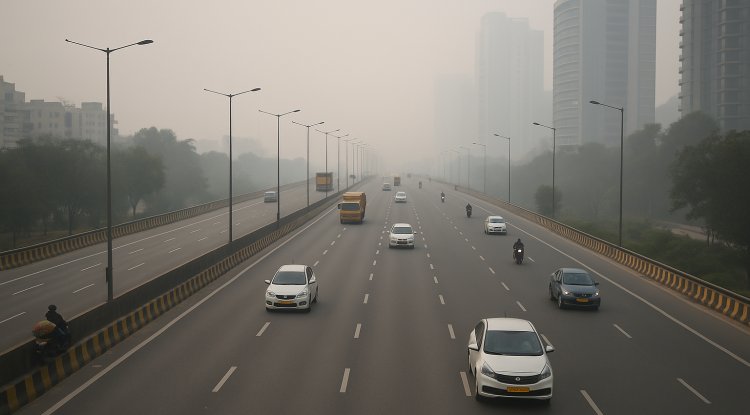Bharalu River: Urban Waterway of Guwahati Undergoing Strategic Review
The Bharalu River in Guwahati, Assam, has long played an essential role in the city’s drainage and ecology. Today, it is part of ongoing rejuvenation efforts under national and urban development initiatives like the National River Conservation Plan and the Guwahati Smart City Project, aiming to enhance its management and ecological value.

India has been reported to have 351 stretches of polluted rivers by the Central Pollution Board (CPCB), some of which are located in urban areas. Bharalu River in the city of Guwahati in Assam is one of them. Historically, the Bharalu, which flows from the Khasi Hills' foothill and joins the Brahmaputra, had both civic and environmental roles to play in the city. It is a fundamental part of the urban water dynamics of Guwahati. It has been the city's main drainage system for centuries and has served to maintain irrigation and fishing in the lowlands it traverses.
Culturally and regionally significant, the Bharalu has shaped the development of many Guwahati neighbourhoods, including Fancy Bazaar and Paltan Bazaar. These have grown up on its banks over the decades, and long-term residents reminisce about its once cleaner state. The river also acted as a natural flood mitigation resource during monsoon, due to wetlands along its course which absorbed excess rainwater and storm runoff.
With the expansion of Guwahati, urbanization and growth of population raised the load on natural water systems. The Bharalu now passes through settled areas, carrying runoff, sewage, and untreated sewage. A large percentage of the city sewage, estimated at 40%, is today directly discharged into the Bharalu untreated, according to the Pollution Control Board Assam (PCBA). This discharge contributes to increased biochemical oxygen demand (BOD) and chemical oxygen demand (COD) values, which are used to assess organic material and water quality. In addition, faecal coliform counts are reported to be above standard thresholds in some stretches.
Despite these pressures, the river remains a vital part of Guwahati’s drainage and ecological network. Conservation and restoration initiatives for the Bharalu have been proposed under a number of national and city-level projects. Rejuvenation works have been designed under the National River Conservation Plan (NRCP) and Guwahati Smart City Project. These comprise the development of sewage treatment plant (STP), improvement of intercepting drains, desilting operations, plastic waste management, and installation of pumping stations to ensure water flow.
The 2019 riverfront reconstruction proposal also sought to integrate infrastructure revival into ecological safeguarding. Desilting, enhancement of the rate of water flux through engineered flow, and redirecting wastewater to treatment infrastructure were proposed. Although schedules for implementation have differed, the planning process mirrors the city's emphasis on integrated urban water management. The cooperation between players like the Guwahati Municipal Corporation (GMC), the Assam Urban Water Supply and Sewerage Board, and the environmental authorities is continuing to coordinate infrastructure for ecological management requirements.
Other than government intervention, citizens and non-governmental agencies have also joined hands for awareness campaigns and riverbank cleaning. These are also a part of attempts to get the population at large involved in the larger discourse regarding sustainable urban living and conservation of water. These initiatives are more geared towards augmenting civic mindedness and complementing government initiatives, particularly in busy areas on the river.
Environmentally, experts state that the condition of the Bharalu presents the possibility of urban water management in India's northeast. The context in which Guwahati is situated—with the hilly terrain and high intensity of monsoon—calls for customized solutions in terms of balancing urban requirements and natural systems. Planning under such circumstances involves not merely physical works but also public awareness, inter-institutional coordination, and data-backed policy interventions.
India's total fresh water supply, though sustained by major rivers, also relies on the condition of small- and medium-sized city water bodies such as the Bharalu. These types of systems, in addition to absorbing stormwater, help regulate urban temperatures and preserve biodiversity. Building resilience into these systems can help a city become more capable of managing seasonal weather patterns such as floods and dry periods.
Urban Indian rivers share the same stress, and the saving of the Bharalu is one step toward more integrated policy to strengthen the nation's water infrastructure and environmental planning. This involves computer mapping of river reaches, interval water quality monitoring, and inclusion of remote sensing technology for flow and sediment monitoring.
The Bharalu will probably play an even larger role as Guwahati expands in the coming years. Future planning includes the possibility of development along riverbanks being made open to public use, subject to ecological impact assessment. Green areas can be provided to residents, improved waste disposal followed, and tourism encouraged, all while ensuring ecological functions through sustainable riverfront developments.
While the city is undertaking new infrastructure under the Smart City scheme, the Bharalu is also a priority area for policy and engineering considerations. Current efforts seek to balance environmental protection with the realities of urbanization and try to achieve long-term sustainability.
What's Your Reaction?
















